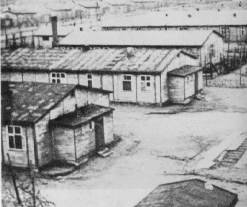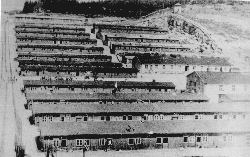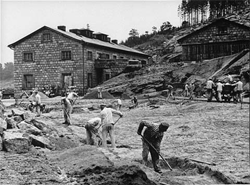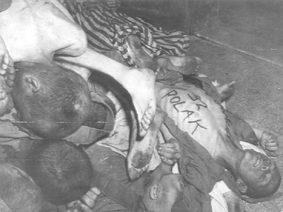
Barracks in Esterwegen
Fernand Van Horen is well known in Belgium under his artist name Horn. Since 1936 and during more than 35 years, he was an illustrator for the famous Belgian newspaper "Le Soir". His humoristics drawings for the "Tour de France" on the last page of the "Soir" are now famous. In 1940, Fernand Van Horen is lieutnant in the 2nd. Lancier, attached to the Belgian Headquarters. On March 1st, 1941 he became member of the Secret Army and took an active part in the fight against the Nazi occupation of Belgium. On February 24th, 1943, he is arrested with 12 companions by the Gestapo. As a partisan, he became "Nacht und Nebel" (Night and Fog) prisoner . He started then his long journey through the Nazi hell.
By Fernand Van Horen, artist name "Horn"
Arrested by the Gestapo on February 24th, 1943, I'm alone in a cell because I am a N.N. prisoner. I am lucky because the rest of my group is directly sent to Breendonck... We all know what this mean...
I am questioned at the Brussels headquarters of the Gestapo, avenue Louise. As I said, as a N.N. prisoner, I have right to nothing (except beatings and torture...). But one day, I'm lucky again: one of the German soldiers pretended that I am a famous Belgian boxer! I try to explain that he is wrong but he insists in order to give me a double ration of food everyday! Of course I stop denying!
To stay during long days alone in a cell is not really pleasant... But I found some exercise books, a pencil and a pencil-sharpener, and thanks to my imagination and my drawings I escape from this cell... (I made my first drawings for "Le Soir" in 1936).
The loneliness of a N.N. prisoner is not total, I can communicate with my companions in the other cells through the heating air-ducts. In this way I learn that we shall be judged by a Luftwaffe Military Tribunal. I even learn the address: rue des Quatre Bras! But suddenly, everything changes! We are sent to Germany! We shall be judged by a "Sonder Gericht", a "Civil" Nazi Tribunal. Not good news!
First stop in Germany: Essen. We are in a huge prison standing alone in the ruins of the city. We are four men to a cell, lying on the ground (no bed of course). During the night, the Allied bombers appear to say a "hello" to the Krauts. The rest of the city is destroyed but the prison is not touched by the bombs. The next day we are sent to the concentration camp of Esterwegen.
Esterwegen
Esterwegen is a camp located near Emden and Papenburg, in a region full of swamps. This region is called "Sauerland". Here are the barracks... The conditions of life are not impressive and the food nearly non-existent but we know there are worst places to be. Each day, some of our companions are sent to the Nazi tribunal for judgment. We never see them again.

Barracks in Esterwegen
During all these days, I spend my idle time with my pencil and paper. I draw the portrait of each of my comrades on the condition that they provide me with the pencil and the paper. I have created hundreds of these drawings. I spend two Christmases in Esterwegen.
One day, I am transferred to Bayreuth, in an old convent converted in prison, located near the famous Wagner's theater. On a morning, a team of Gestapo agents arrives in the prison and begin to question all the inmates. We realize that they have absolutely no documents, nothing in order to lead these interrogations. The bombers have destroyed the archives of the Gestapo! And, of course, we all pretend that we are poor innocents civilians wondering what we are doing here, but the Gestapo doesn't give up so easily, on March 10th, 1945, we are all sent to a death camp.
Flossenbürg

General view of the camp, probably the day of its liberation
Flossenbürg is located in Bavaria. Most of the inmates are Russians or Polish. The conditions of life are incredible. Nobody can imagine the bestiality and the cruelty of the SS guards. It is really hell here! And there are very few survivors of this hell!
We entered a barrack and are immediately faced with what will be common for us in the next months; an inmate is beaten to death with a whip. We don't know the reason why this poor fellow is beaten to death. Torture, shootings, hangings, all of this is just normal life in Flossenbürg. The most common threat of the SS is "Krematorium"!
The day after our arrival in the camp, we are sent to a kommando: we must take huge stones on our back and transport it from one hill to an other. Of course, we are beaten during the whole day with clubs, rifles, etc. I soon realize that we have no chance to survive from here. But once again, I am lucky... A miracle!

A "kommando" in Flossenbürg
The bag containing my clothes is stored in a room located beside the crematories. A "kapo", a German criminal, has found the exercise books with all the drawings I made in the prison of Saint Gilles, Brussels. And my name is on each cover! Immediately, the guard begin searching for me in the camp. He explained to me; here is the deal: if I draw his portrait and fill his room walls with humoristics drawings, he will take care of me and remove me from this work team! I ask to my friends what should I do and they all tell me that I must accept the deal, maybe I'll be able to help them later.
But two days later, the worst happened: I have diarrhea and I'm suffering like hell. The SS guards gives me a delay of four days to become well... after, it is the crematory! The kapo amateur of drawings sends me to the infirmary.
In the infirmary, we receive no medical care of course! The only "good side" of this crematory antechamber is the silence. I am forced to stay for a while under a freezing shower and I am placed in a "bed". The bed is just a wooden box with just enough room for one man. An inmate is lying in the box, and he is in coma. He died quickly.
I stay three days and three nights, naked, with this corpse just on me. The "bed" is full of excrement and I am so weak I am not able to push the body out of the box. I am wondering why the Russian inmate in charge of the infirmary do not remove the corpse out of this place... I understand later: this frozen body represents three rations of food for him.
My friends have been sent to another kommando: they have to destroy non-exploded bombs. There is something strange! The SS leaves the camp alone, then comes back with several of them wounded by gunfire. During the night, hundreds of inmates from other camps arrive. They are exhausted, really in a pitiful condition. They have to stay the whole night outside... and it is freezing! The day after there are corpses lying everywhere in the camp.
Suddenly, several armed SS enters the infirmary! Is it the end for us? Will they shoot us? No! They leave with all the inmates able to walk. We shall find several of these poor men shot, 100 meters from the entry of the camp... We are waiting the whole day, wondering what shall happened in the next hours and if the SS will return. The day after is sunny. I leave my "bed" and slowly, painfully make my way out of the barracks area. The only clothing I am wearing is a cover full of excrement. Suddenly we hear the noise of automatic rifles! On the hill we see hundreds of soldiers! The SS are coming back!
A tank enters the camp, destroying the gate. We all see a white star on its side!!! These soldiers are not SS, They are American GI's!!!
How to explain what we feel in this moment. The joy is so intense that I am suddenly feeling weak. I laboriously make my way back to my "bed", this disgusting box full of excrement, and crawl in with my dead companion, the corpse is still there! Today, it is April, 23rd., 1945.

Liberation of Flossenbürg: for them, it was too late...
The first American soldier enters the infirmary. I try to translate what he is saying because all the other inmates are Russians or Polish and, of course, they don't speak English. The poor guy can't believe what he is seeing in this infirmary. I try to explain him what happened then I ask him to stay still: I draw his portrait. And this brave soldier leaves proudly, with his portrait in his hands...
Big mistake! In the following minutes, all the soldiers are asking for a portrait!... Despite of my fever, I try to satisfy everybody!
After some weeks of recovering, I come back in Belgium with two other Belgian "N.N." inmates. The Belgian minister Van Zeeland has sent a unit of para-troopers in order to escort us back. We are home on May, 7th 1945.
Epilog...
Twenty seven years later, in the afternoon of September 1st., 1972, I have a phone call from the Hotel "Palace" in Brussels. It is an American tourist who wants to meet me. He pretends he met me in Germany in 1945. OK, let's see!
At the lobby of the hotel, a man is waiting for me. He has a drawing in his hands. What a surprise: he is one of my liberators of Flossenbürg!!! What is he doing here?
Here is the story. In 1945, in the chaos of the last months of the war, the famous Lipizzans horses of the Spanish School of Vienna are lost... These incredible horses are sought by the Germans and the Russians. The colonel Podhajsky, commander of the school had asked help from General Patton. General Patton had immediately sent a unit with one unique mission: to retrieve these horses... and they did it!
For the 400th anniversary of the famous Spanish School of Vienna, the survivors of this unit were invited by the Austrian government. This travel and the wonderful celebration offered by the Austrian government are described in a kind letter we have received from the spouse of my American liberator, Mrs. Willard-Burdick, Jackson, Michigan. She traveled with her husband.
And that was the reason they were here: their first stop in Europe was Brussels. Since my name and address was written on the back of the drawing, it was not too difficult to find me!
We had a wonderful dinner in a restaurant in the heart of Brussels. We had so much to discuss... The day after, they left for Vienna, on the same roads my liberator had crossed in 1945...